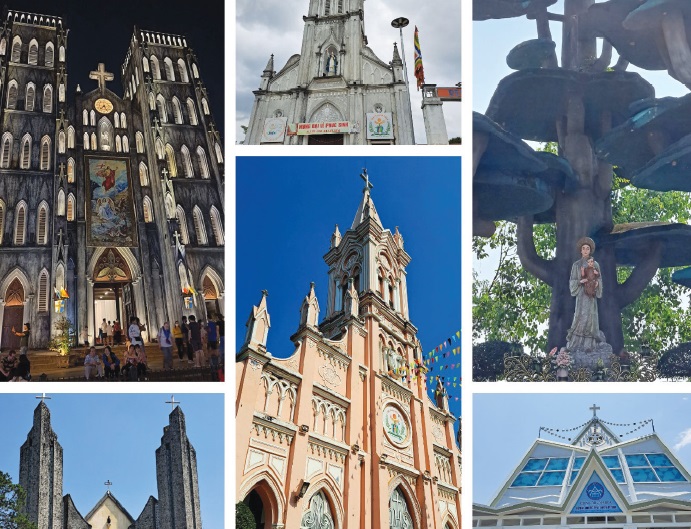Persecution not a deterrent to Catholicism in Vietnam
On November 24 each year, the Church in Vietnam celebrates the Feast of the Vietnamese Martyrs to honour those who died for their faith.
May 26, 2023

By Evelyn Khor
On November 24 each year, the Church in Vietnam celebrates the Feast of the Vietnamese Martyrs to honour those who died for their faith. It is estimated that between 1630 to 1886, some 130,000 to 300,000 Christians were forced to flee to the mountains to escape being killed and tortured for their beliefs. In 1785, a group of persecuted Catholics sought refuge in the rainforest of La Vang and would gather every evening under a large tree to recite the Rosary.
Many were malnourished and suffering from various ailments and lived in fear for their safety. In 1798, Our Lady, dressed in traditional ao dai with the child Jesus in her arms and flanked by two angels appeared to them and instructed them to brew tea from bushes that grew nearby to treat their ailments. Word of her apparition and the miracle healing tea spread and the apparition also brought about many conversions to Catholicism. Since the late 17th Century, French missionaries of the Foreign Missions Society (MEP) and Spanish missionaries have evangelised in Vietnam. Today, they have approximately 7 million Catholics, representing seven per cent of the total population.
On May 4, Fr George Packiasamy from the Church of St Thomas, Kuantan led 24 pilgrims from his church and other parishes in the Klang Valley to pay homage to Our Lady of La Vang. Many of us felt blessed to be able to pay homage to our Blessed Mother, who had healed and protected so many during the time of Christian persecution. Like many who have made this pilgrimage to our Lady of La Vang, we came to honour her and seek her intercession for our various intentions at her shrine. A chapel was built in 1820 but was destroyed during another wave of persecutions that almost decimated the Catholic population. A new chapel was constructed in 1886, which was later elevated to a minor basilica in 1961, only to be destroyed during the Vietnam war.
What remains of the original minor basilica today is only a partially bombed bell tower — a stark reminder of the Vietnam war and the immense suffering and hardship endured by the Vietnamese people.
As we prayed and celebrated Mass at the shrine accompanied by the sound of leaves rustling in the wind, one could not help but remember those who had sought refuge in the forest during the period of persecutions against Christians. A mural at the site depicting 117 known martyrs who died for their Catholic faith during the 18th and 19th centuries was a further reminder to us of how these brave men and women had stood firm in their faith right to the end. The martyrs in the mural included 96 Vietnamese, 11 Spanish and 10 French nationals. Eight were bishops, 50 were priests and 59 lay Catholics among whom was a nine-year-old child and Agnese Le Thi Thanh, a mother of six. Saints Jacques Honore Chastain, MEP, Laurent Marie Joseph Imbert, MEP, and St Philip Minh and companions (Vietnamese Martyrs) who at one time were studying and lecturing at College General, Penang, were also depicted in the mural. Every year, College General celebrates their feast day on June 19.
We had begun our pilgrimage from KLIA on May 1 and landed in Hanoi in the evening, which also happened to be the Feast of St Joseph, the Worker. We were truly blessed not only to begin our pilgrimage with a visit to St Joseph’s Cathedral but also to attend a grand celebration befitting the feast of St Joseph. Built in 1884, the cathedral, which is the oldest church in Hanoi, was constructed by French missionaries, and its stained-glass windows and interior reflected many of the gothic features of churches in Europe. It was an experience for us to celebrate Mass in Vietnamese and to listen to the hymns accompanied by music played on the grand pipe organ, the sounds of which reverberated through the cathedral, adding a touch of grandeur to the celebrations.
During our pilgrimage, we had the privilege of celebrating Mass at different venues including lesser-known churches. The Trap Khe parish church was one such place. Tucked away in a housing area, it was built in 1884 but was destroyed during the war and only restored in 2011.
Worshipping at this small hidden church was a humbling experience as it reminded us of how the Catholic Church and her faithful people had survived persecutions at various times and later suffered much during the Vietnam war which lasted from 1954-1975. Another beautiful Mass was celebrated at Our Lady of Tra Kieu Church located right on top of a hill. The site was a challenge for some as it meant climbing more than a hundred steps up to the shrine. However, with faith, all of us made it up to the shrine where Fr George celebrated Mass and anointed all the pilgrims at the shrine which has a sweeping vista of the beautiful countryside. Perhaps one of our most unforgettable venues for Mass was on the top deck of our cruise boat on Halong Bay on the third day of our arrival. As the sun rose over the unique limestone formations in Halong Bay, our hearts were filled with gratitude as we received the Eucharist and rejoiced at the beautiful day that the Lord had made.
On our last day in Danang, Fr George shared a breakfast table with Dawn Chung — a young Vietnamese girl who had migrated to America and was now back on a visit. She told him that she was one of the boat people who had landed in Pulau Bidong as a child and later stayed at the Sungei Besi refugee camp while waiting to be resettled in America. As Fr George shared later after our morning prayers on the way to the airport, Dawn is a reminder to all of us not to forget the Vietnamese refugees, many of whom perished as they attempted to flee Vietnam and make the perilous journey by sea (South China Sea) to Malaysia. He told us about the graves — both marked and unmarked in Pulau Bidong, Dungun, Kuala Terengganu, Kuantan and various places along the east coast which stand as a reminder to us of those who had suffered much but did not make it in the end. Fr George also had a chance to share with Dawn about our Lady of La Vang and just as she had protected those who had sought refuge in the forests, she would have also watched over many who risked their lives to escape by sea and comforted those who had lost their loved ones. As the Patroness of Vietnamese Diaspora, our Lady of La Vang is as relevant today as when she first appeared in the forest in 1798.
In the face of a global refugee crisis and people being driven from their countries because of conflicts, let us continue to pray for those seeking refuge and let us pray that our Blessed Mother move the hearts of governments to open their country’s borders and provide humanitarian aid for the many who have been displaced.







Total Comments:0